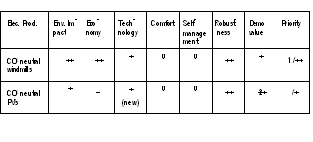 |
 |
 |
 |
 |
 |
 |
 |
 |
 |
 |
 |
Decision making process
Name of the case study
Sustainable building on the Teglmose site in Albertslund
Decision making process - stages
The evaluation and selection of initiatives consisted of the following phases:
• An analysis of local physical conditions and local supply systems and an evaluation of the flows of energy- and material that the buildings would cause. The analysis covered a registration of the architectural characteristics of the municipality, and the local infrastructure and landscape. This included environmental problems, actual and planned capacity of the infrastructure plants etc. for heat and electricity supply, waste and wastewater treatment.
• A dialogue workshop with local key persons produced visions and criteria for the Teglmose site. Also, the environmental demands from the municipality of Albertslund and their Agenda 21-plan were as incorporated. On the basis of this the municipal developed a list of overall criteria for the building. This included goals to reduce fossil fuels, reducing groundwater consumption, encourage local percolation of rainwater, reduce the number of environmental harmful substances in the wastewater, and minimising waste.
• In the fall of 2000, an idea competition was completed for the site. 6 contributions were submitted, including suggestions for the buildings and the green initiatives.
• Multi criteria screening. All the green initiatives presented in the different contributions in the competition were collected in a gross-list. The screening was based on a rough estimation of the importance for environment, community etc., contrasted the expected barriers in terms of economy, organisational conditions, technology and comfort (see below).
• The screening led to a number of demands for the buildings and tender documents were produced.
• The municipality made a legally registration (tinglysning) of the demands on the Teglmose site, so that they will apply for all owners and users in the future.
The multi criteria screening

Example on the screening-scheme set up for a quick assessment of the different possible efforts suggested in the idea-competition. The benchmarks were assessed according to the performance compared to traditional practices – and in relation to the local context.
Formulation of the demands
The demands were formulated in a hierarchical way: The building had priority compared to the building parts, and the building parts compared to the building components. The idea of defining general goals was to give the designers large degrees of freedom to establish creative solutions on how to achieve these goals. E.g. no specific guidelines were given on which materials to use. Recommendations and minimum demands for the future building were described in 3 levels according to the traditional decision levels in the Danish building process: a master plan (official approval), a building scheme (official approval) and a detailed project. The demands were further detailed in relation to functions and methods. An e.g. of a functional demand is that the heat consumption is to be max 33% of the standard in the building code (BR 95). Thus the demand is not directed towards a specific component e.g. windows, but the designer has to document that the buildings live up to the demand. An example of a methodological demand was that alternatives for central building parts had to be environmentally compared, using the LCA-tool BEAT 2000 (see WP 2 or description).
Decision making process - levels
Technical and political
Decision making process - sources of information
Discussions and decisions on different solutions were taken at workshops with key actors.
Decision making process - who are the decision makers
The main decision-maker is the municipality of Albertslund. This includes both politicians and municipal planners and technicians, who were very proactive in making a ´green´ project. As the municipal owned the building site they could increase the requirements for the green qualities of the building project.
The other actors included in the process were primarily:
• A group of local key persons (citizens) including representatives from the future inhabitants participated in a dialogue workshop creating visions for the Teglmosegrunden. During the process an association of future residents was established with the objective to build on the site. The cooperated with the municipality to establish high quality green buildings and surrounds.
• 6 firms were invited to join an architectural competition to produce a unified plan for the area and for the green residents.
• The consultant was in charge of the process including the application of the tool. The consultant was part of the team who developed the tool.
Decision making process - who made the final decision for project implementation
Name of tool
Context analysis
Decision making process - tools in decision-making process
The tool implied a new type of decision-making procedure, compared to traditional buildings (including stakeholders, defining goals etc.).
The tool operates with quantitative benchmarks of different aspects involved in the planning process. The benchmarking compares to traditional building qualities, as defined in the building regulations. The idea was to define quantitative goals, and let the consultants and designers decide how they would accomplish these goals.
Decision making process - how was the information for the dmp disseminated
Decisions and alternatives were open discussed at workshops with key actors involved.
Decision making process - how was the public involved
The coming residents of Teglmosen were participating in the workshops
Decision making process - was there public discussion over the project
Other citizens are invited to give their opinion through the local planning procedure, which, according to the planning act requires a hearing period for neighbours
What tools were used to assess sustainability?
Context analysis
More information